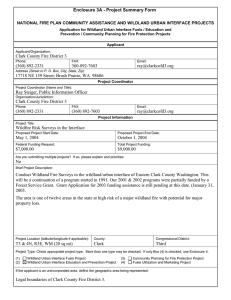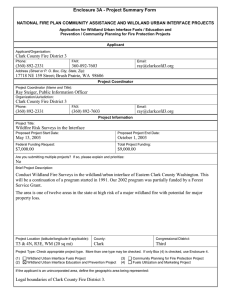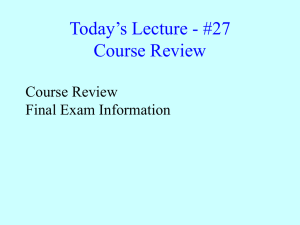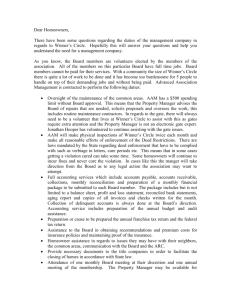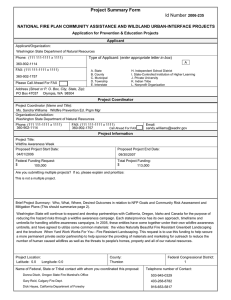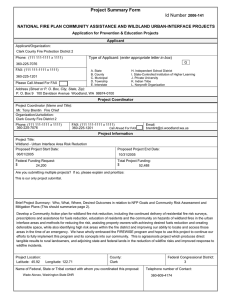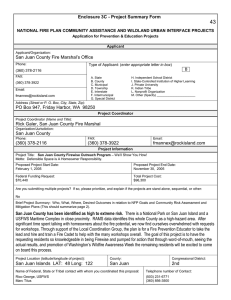Project Summary Form Id Number 2006-129
advertisement
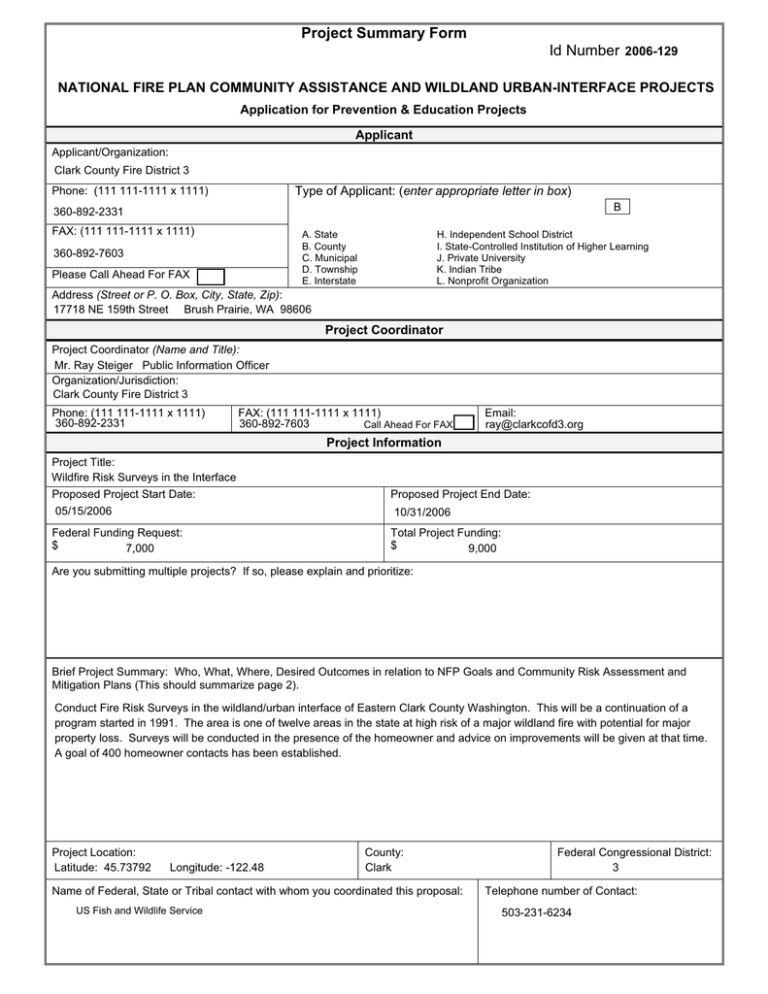
Project Summary Form Id Number 2006-129 NATIONAL FIRE PLAN COMMUNITY ASSISTANCE AND WILDLAND URBAN-INTERFACE PROJECTS Application for Prevention & Education Projects Applicant Applicant/Organization: Clark County Fire District 3 Phone: (111 111-1111 x 1111) Type of Applicant: (enter appropriate letter in box) B 360-892-2331 FAX: (111 111-1111 x 1111) A. State B. County C. Municipal D. Township E. Interstate 360-892-7603 Please Call Ahead For FAX H. Independent School District I. State-Controlled Institution of Higher Learning J. Private University K. Indian Tribe L. Nonprofit Organization Address (Street or P. O. Box, City, State, Zip): 17718 NE 159th Street Brush Prairie, WA 98606 Project Coordinator Project Coordinator (Name and Title): Mr. Ray Steiger Public Information Officer Organization/Jurisdiction: Clark County Fire District 3 Phone: (111 111-1111 x 1111) 360-892-2331 FAX: (111 111-1111 x 1111) 360-892-7603 Call Ahead For FAX Email: ray@clarkcofd3.org Project Information Project Title: Wildfire Risk Surveys in the Interface Proposed Project Start Date: 05/15/2006 Federal Funding Request: $ 7,000 Proposed Project End Date: 10/31/2006 Total Project Funding: $ 9,000 Are you submitting multiple projects? If so, please explain and prioritize: Brief Project Summary: Who, What, Where, Desired Outcomes in relation to NFP Goals and Community Risk Assessment and Mitigation Plans (This should summarize page 2). Conduct Fire Risk Surveys in the wildland/urban interface of Eastern Clark County Washington. This will be a continuation of a program started in 1991. The area is one of twelve areas in the state at high risk of a major wildland fire with potential for major property loss. Surveys will be conducted in the presence of the homeowner and advice on improvements will be given at that time. A goal of 400 homeowner contacts has been established. Project Location: Latitude: 45.73792 Longitude: -122.48 County: Clark Name of Federal, State or Tribal contact with whom you coordinated this proposal: US Fish and Wildlife Service Federal Congressional District: 3 Telephone number of Contact: 503-231-6234 Describe project, including, but not limited to: x type of project to be delivered x project location x method of delivery x project relationship to community or natural landscape fire plans x target audience x timeliness x tools and/or skills needed to complete project x projected timelines and cost estimation x monitoring and evaluation procedures For this project, explain the level of cooperation, coordination or strategic planning, through a “Local Coordination Group.” If you haven’t worked with a local coordination group, why not? Response: Much of the eastern half of Fire District 3 is in the forested foothills of the Cascade Range. The area is relatively accessible and is in private ownership. Clark County is the fastest growing county in the state. Many people are building and living in what has become 1 of 12 areas in the state likely to experience a major wildfire with major property damage and potential loss of life. This project, if funded, will be year eleven [11] of a program to contact homeowners in this interface area, and with them conduct a fire risk survey of their home and property. The area has many homes tucked away amongst the trees, some with very poor access and with no visible addresses. The area is also subject to occasional strong, drying east winds. We feel a real urgency to inform homeowners of the risks and what they might do to improve their chances of survival. Previous surveys were conducted through grants provided by USDA Forest Service, USDI Fish and Wildlife Service, Department of Natural Resources and Southwest Washington Independent Forward Thrust [SWIFT]. Limited staffing and funding, combined with increasing emergency responses has put a premium on the time of personnel at the Fire District. It is this that requires we hire at least two temporary summer employees to carry out this program. The program creates two local jobs. College students have proven to be a good resource for the survey team. Our goal is to make personal contact with at least 400 homeowners this summer. Valuable statistical information for pre-fire planning purposes was acquired during the course of the surveys. More importantly was the opportunity to educate and inform homeowners in the "interface" about ways they can protect themselves and help defend against wildfire. The one-on-one contact was very effective in convincing homeowners to make necessary fire safety corrections. The primary objective of this project is public education, about the means homeowners can use to protect their property from wildfire, and to prevent a house fire from spreading into the forest. A secondary objective for the Fire District is to gain a more comprehensive vision of problem areas in the event of fire. Factors relating to evacuation, resources needed, and values involved are critical in pre-fire planning. Benefits are reduction of loss of natural resources, private property, and human lives. Short-term outcome is many people will become informed as to what they can do to protect their home. A large percent will take immediate steps to correct problems. Long-term outcome is a more fire conscious population and an improvement in conditions in our interface area. This project is relatively easy to administer and can be used by other communities or agencies. We are willing to help others with the development of their own program. The success of this project can be measured by the degree of acceptance of the recommendations given to the homeowner. In previous years, a very high percentage of homeowners contacted in follow up phone calls either had or said they would make the recommended improvements. The personal contact, ease and inexpensive nature of simple improvements, combined to make this program a success in the past. 1. Prevention of Wildland Urban Interface Fire (40 points) Describe how the proposal will lead to: A. Reduction of wildland urban interface fire B. Reduction of structural losses C. Homeowner action and personal responsibility to reduce fire loss of private land. Response: The major emphasis of this program is to reduce fire risk and property loss in the wildland/urban interface area of Fire District 3, an area of approximately 83 square miles. This area has been designated, by the State, as 1 of 12 areas in Washington at high risk of a major fire with potentially major property loss. Reduction of fuels around homes, more fire resistant construction, better access and address signing will lead to better fire protection for homes, land resources and wildlife. It also reduces chance for fire to spread to nearby state and federal lands. This year's project goal is to contact and work with 400 homeowners. In the past this program has allowed us to contact about 7,000 homeowners, a high percentage of whom have or committed to make recommended improvements. Over the past years, we have seen a remarkable improvement in defensible space around many of the homes in the interface area, due in large to our effort to inform, educate, and involve the property owners. It is evident that many homeowners have taken steps to improve their chances of survival. We have been gratified by public acceptance of the program in past years. Based on the estimated population in the wildland-urban interface and adjacent area we believe 16,000 people directly and indirectly benefit from this program. 2. Community Participation (30 points) Detail the community participation and collaboration for this project. Define clearly why you believe your group will be successful in delivering the proposal to the target audience. How will the project be sustained or carried forward beyond project timelines? How will the project be monitored and evaluated? Response: This is a program that Fire District 3 has conducted for 11 years, and will continue, as funding is available. We are committed to the program as we have seen the benefits from it. As in the past, our outreach will consist of news releases, and our own Fire District Newsletter that reaches everyone within the District's boundaries. Included in these news releases are local and Portland based media, who have given the fire district excellent coverage in the past years. This has led to a better-informed public about the need for homeowners to be involved in helping protect their communities from fire. In-kind contributions consist of volunteer time estimated at 80 hours, for program coordination, media contacts, homeowner contacts, and some follow-up after the survey team is finished. It also consists of clerical, benefits, vehicle fuel, uniforms, vehicle insurance, supplies, and some managerial salary costs. Our program has become a model for other Fire Districts in Southwest Washington and we have been requested by local federal agencies to help train others. This project will be sustained by volunteer employee participation. The Project coordinator through random field checks and homeowner contacts will do monitoring. The evaluation is completed by the Fire Chief and staff. 3. Partnerships (30 points) Detail the level of involvement of any local multi-agency, emergency services, non-profit coordination group, and provide a list of partners for this project with their current and expected level of involvement, including any kind of contributions or matching funds. What is the project relationship to a community risk assessment or mitigation plan? Include the name of the plan, date it was prepared, and local contact to get a copy of the plan if requested. Response: State and Federal agencies, including the Pacific Northwest Interagency Fire Prevention Group developed the guidelines we are using for our surveys. The expertise of these groups in developing the necessary guides for fire safe homes and communities is the technology we transfer to the private land and homeowners. The success of this program in helping to prevent the spread of fire and reduce fire loss, can have an immense effect on the resources of ours as well as other local fire jurisdictions including State and Forest Service. Our program is a partnership between Fire District 3, our taxpayers and homeowners. We provide the knowledge and encouragement, they provide the labor. We have always coordinated our program with projects and programs conducted by Washington State Department of Natural Resources. Project Work Form Tasks Time Frame Media Contacts (Ongoing) Responsible Party Ray Steiger, Public Information Officer June 1, 2006 - Oct 1, 2006 Recruit and Hire Steve Wrightson, Fire Chief May 15, 2006 - June 1, 2006 Training District Personnel June 20, 2006 - June 30, 2006 Survey Team Start Homeowner Contacts July 1, 2006 - Sept 1, 2006 Progress Review Steve Wrightson, Fire Chief Ray Steiger, Public Information Officer July 30, 2006 Survey Team Complete Contacts and Reports August 25, 2006 Release Survey Team Steve Wrightson, Fire Chief September 1, 2006 District Personnel Follow up as needed Sept 1, 2006 - Oct 31, 2006 Project Budget Cost Category Description Federal Agency Applicant Partner 1 Partner 2 Total Partner 3 Personnel 650 Hours @ $10 hour Supervision, Clerical Subtotal $0 $0 $0 $0 $0 $1,100 $0 $0 $0 $1,100 $6,500 $1,100 $0 $0 $0 $7,600 $0 $0 $200 $6,500 $6,500 Fringe Benefits Social Security, Ind. Ins $0 $200 $0 Unemployment $0 $0 $200 $0 $0 $0 $0 $0 $0 $0 $0 $200 $0 $0 $0 $0 $0 $0 $0 $0 $500 $500 $0 $0 $0 $0 $0 $0 $500 $0 $0 $0 $0 $0 $0 $0 $0 $0 $0 $0 $0 $0 $0 $0 $0 $0 $0 $0 $500 $0 $0 $0 $500 $0 $200 $0 $0 $0 $200 $0 $700 $0 $0 $0 $700 $0 $0 $0 $0 $0 $0 $0 $0 $0 $0 $0 $0 $0 $0 $0 $0 $0 $0 $0 $0 $0 $0 $0 $0 $0 $0 $0 $0 $0 $0 $0 $0 $0 $0 $0 $0 $7,000 $2,000 $0 $0 $0 $9,000 $0 $0 $0 $0 $0 $0 Subtotal Travel Vehicle Use 1235 mi @ $0 .405 Subtotal $500 Equipment Subtotal Supplies Printing, Radio Use Uniforms Subtotal Contractual Subtotal Other Subtotal Total Costs Project (Program) Income1 ___________________________________ 1 Program income is the gross revenue generated by a grant or cooperative agreement supported activity during the life of the grant. Program income can be made by recipients from fees charged for conference or workshop attendance, from rental fees earned from renting out real property or equipment acquired with grant or cooperative agreement funds, or from the sale of commodities or items developed under the grant or cooperative agreement. The use of Program Income during the project period may require prior approval by the granting agency.
